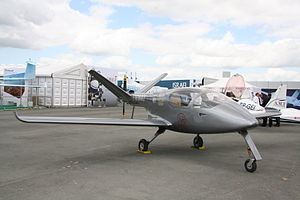Top speed 287 km/h Length 6 m | Wingspan 7.7 m First flight July 9, 1995 | |
 | ||
The Ameur Altania was a single-engine light aircraft of pusher configuration with side-by-side seats for two and a V-tail, designed in France in the 1990s. Several prototypes were built and flown, including a 15 m span motorglider version; the final prototype was constructed from carbon composites rather than glass fibre. Another version, the UCA Carbon Bird has been built by Universal Composite Aviation after the bankruptcy of Ameur Aviation.
Contents
Design and development
The Altania was designed by the Sardinia-based Ameur Aviation Technologie group (AAT) as the AAT Balbzard (Osprey in English). It was a low-wing monoplane of pusher configuration, with a single buried engine driving a propeller at the extreme rear via a long driveshaft. The engine was mounted over the wing with a dorsal shallow air intake just behind the cabin. Behind the engine the fuselage became a slender boom, terminating in a butterfly tail and two ventral strakes. The cabin seated two side by side, with a small luggage space behind, and was enclosed by a forward-hinged, single piece canopy. There was a retractable tricycle undercarriage with inward retracting mainwheels, fitted with hydraulic brakes.
The first prototype Balbuzard flew on 9 July 1995, powered by a 60 kW (80 hp) Rotax 912. Like the next three prototypes, this aircraft had a glass fibre structure. The second prototype had an 88 kW (118 hp) Textron Lycoming O-235 engine, driving a three-blade, fixed pitch propeller, and a longer span and lower set wing fitted with winglets. The undercarriage height was also increased. The similarly-powered third prototype was renamed the Baljims 1A because of copyright issues. Between them, the second and third prototypes achieved 350 hours of flight testing. The fourth prototype was a long span (15 m or 49 ft 2.5 in) motorglider, only flown for 30 hours before its development was abandoned.
The glass fibre construction of these prototypes led to excess weight and the fifth aircraft, the Ameur Altania prototype, was built from pre-impregnated carbon-epoxy and honeycomb. The fuselage was single piece and the single spar wing had double-slotted flaps and upturned tips. It flew in December 2001. Several production variants were projected: The Altania RG 80 UL; the Altania Vista surveillance aircraft; the Inguidar trainer; the Altania Saphir, a four seat, kit built development; and the UAV MALE, a pilotless drone. The most radical variant was the Ameur Altajet, a pure jet version powered by two wing root positioned, 3.43 kN (770 lb st) thrust Williams EJ22 engines. None of these variants were built, though the Altajet, at least, reached the mock up stage.
The second prototype F-W(P)ARA was lost in 1997 when the propeller driveshaft failed in flight; the fifth prototype aircraft/first Altania F-WWMU is recorded as damaged in July 2005, with no mention of repair. AAT was declared bankrupt in 2006 but the Altania design was taken up by Universal Composite Aviation (UCA). The four-seat UCA Carbon Bird CB-200 appeared at the Paris Aero shows of 2007 and 2009, though not in 2011; its current status is unclear.
Specifications (Altania RG 80 UL)
Data from Jane's All the World's Aircraft 2006/7 Unbuilt variant, estimated data.
General characteristics
Performance
Avionics
